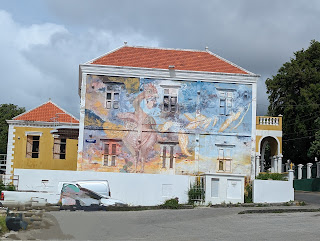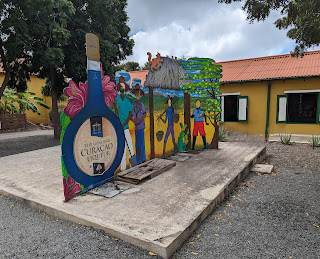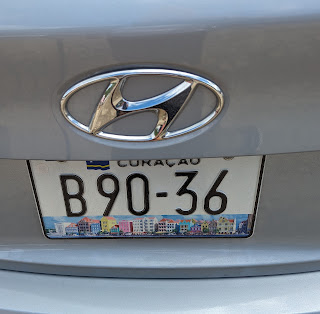The Naked Chicken by muralist Marcus Sling, according to the driver, represented the fact that in Curaçao everyone can live how they want regardless of race, sexual orientation, etc. The island's Golden Rule meant never discussing politics or religion!
It was no time at all before we realized that Willemstad is a treasure trove of street art and Colorful Steps was a great example of Kayaka, street parties Otrabanda residents host to encourage artists to decorate their exterior walls. Some people even repaint their homes every Christmas!
At the top of the stairs was this mural and another Curaçao Chichi Doll sculpture. I wondered how many more of the sculptures we'd find before the day was over!
Curaçao's population is 160,000 with a whopping 65% being Roman Catholic.
At the top of the Otrabanda area was a majestic former plantation house. Because the exterior was originally constructed with coral stone and cow poop as plaster, the overpowering smell meant that residents had to wait two weeks to move in! In the plaza out front was Watch Dog built from recycled materials.
We loved how colorfully the buildings were painted with nary a beige one to be seen. The locals attribute the bright colors to a governor in the 1800s who blamed the glare of the sun's reflection on the then-white buildings caused his migraines. He demanded the owners use colored paint on their houses to relieve his migraines. Later, it was discovered that the governor had ownership in a paint company!
The newly renovated Belvedere B&B looked pretty chichi!
More memorable street art in Otrabanda:
Some Curaçao fun facts: A female governor now heads the country for the first time. She declared she didn't want to live in the Governor's House as she already had her own! The only animals hunted on the island are iguanas; the $4 cost of gas is the same price at every station so stations must compete in other ways to attract customers; schools are free until junior college.
Shell opened its oil refinery on the island in 1929 but they abandoned it in 1986 without cleaning up their mess, according to our guide. After Venezuela took over with a 30-year lease that expired in 2019, 7,000 workers lost their jobs when the refinery closed just before the pandemic. The Netherlands government came to Curaçao's assistance when the economy dried up with the absence of tourists. Tourism is now three times larger than it was before the pandemic. The refinery had just reopened the week before we arrived in late January.
Our last view of Otrabanda before moving on to the Scharloo district, where the early Jewish community of bankers and merchants built their stately homes.
The homes along Scharlooweg were particularly magnificent.
This was considered a 'status building' because of its many windows and elaborate ornamentation.
Out front, the Nanny or Yaya sculpture was built from car bumpers!
'The house of many windows' indicated more children lived there.
The Central Bank of Curaçao and St. Maarten was the island's most expensive building because of its marble exterior.
During WW II, this home was the site of a hidden synagogue because the Allies were supplied with fuel by the islanders. A German sub tried to enter the harbor but it was sunk outside it. Notice the Star of David design on the gate. The home now belonged to an island war hero.
Apparently, this pale green mansion was the island's most photographed building. It was dubbed the 'Wedding Cake House' for its layers and detailing every place you looked.
The 'bride' or perhaps the Starbucks barista was featured in the right-hand corner!
Romance at 3pm was another eye-popping work of art by Curaçao muralist Sling.
These homes were constructed for slaves by the oil company.
According to our guide, first-generation slaves occupied these ochre-colored homes when they moved to the city.
At the city's Jewish Cemetery, all the tombs were built above ground because the city was built on bedrock.
What would any group tour be without a stop at a shop in an effort to extract our moolah?! Landhuis Chobolobo was a distillery that featured the famous blue, 31 percent proof Curaçao liqueur made from the peels of bitter laraha oranges, cardamon, and cloves.
The originial copper still was 'still' in use today.
Steven naturally pointed to his Chobolobo liqueur of choice: the 41% proof on top compared to the measly 31% proof bottles on the second row! Those in the second and third rows all tasted the same but were in different colored bottles.
Those not wanting to buy liquor could buy the company's multi-purposed mentholated lotion to refresh when hot, relieve a fever or headache (perhaps a hangover!), relieve itching and stomach aches, soothe muscles, and as an aftershave!
I bet crossword fans get a hoot out of this beverage list!
The monument represented the link to The Netherlands, the old mother country. Our guide said the majority of people on the island were of mixed race and that her own family looked like a box of crayons! Some were naturally blond, some were Black, some had green eyes, and others had gray eyes.
Ever since flamingoes got lost during a storm thirteen years ago, they've returned annually but go to the island of Bonaire during mating season.
After being cooped up on the bus for a few hours, it was great to stretch our legs for an hour at Kokomo Beach, one of 38 beaches on the island.
I always enjoy looking at license plates wherever we go. Perhaps that stems from our adopted state of Colorado which has about one hundred different plates to choose from. Hands down the most beautiful one is the one from Curaçao with its iconic row houses.
Just behind a mangrove forest was Parke Lucha Pa Libertad or Fight for Freedom Park, a tribute to the 1795 historical freedom fight against slavery. Made of stainless steel to withstand the damaging salty air, the gate by Giovanni Abath, depicted figures holding up their arms in the shape of the letter V, representing victory, to demonstrate that they were now free and not shackled. The three different-sized figures represent the three social classes in society: the higher, middle, and lower classes. The most eye-catching part of the gate featured the continent of Africa where the enslaved people came from to work on the island’s development.

In August of 1795, a slave revolt erupted in Curaçao led by Tula, an enslaved man, who knew slaves on other islands had been freed. He was granted permission after asking to speak to Curaçao's Governor General. However, Tula and the other leaders of the revolt were ambushed and beheaded, an event marked each year by the island's residents. In 2023, the king of The Netherlands apologized for the country's role in the slave trade. The Netherlands was the last European country to abolish slavery.
The sculpture honored Tula and the other leaders of the revolt.
The pole marked the history of the island's independence.
This last sculpture in the very moving Freedom Park was titled Free At Last. The guide told us that Curaçao music originated in Africa and was used to communicate with slaves on other plantations. The music, now known as Tamu, is still used in protest songs.
As we passed the oldest Catholic cemetery on the island, our guide mentioned that families pay a yearly maintenance fee for the plots, like a timeshare! There are four people in each mausoleum - when another family member dies, the oldest person's remains are removed and buried elsewhere.
Since rain earlier had prevented the guide from showing us more murals in the Otrabanda district, we returned. Know yourself and you will know the universe was the title of this work made with recycled materials.
After being gobsmacked by some of the best murals and street art we've seen anywhere, we could easily understand why residents are choosing to move back to the Otrabanda district. What an incredible revitalization project the city has undertaken.
On the left, the island's strong Catholic presence was represented by Archangel Michael.
Flowers of the Sky was created by the same artist who built the Freedom Park gate.
So many aspects of the tour had been excellent - the guide enthusiastically shared her deep knowledge of, and love for the island. Plus, learning of Curaçao's slave history was a huge bonus as it hadn't been on the original itinerary. However, I would have preferred the tour had skipped the distillery stop so we had time to wander through the Scharloo district as we did Otrabanda and at least driven through the historic district of Pietermaai.
Steven and I spent the rest of the afternoon exploring downtown Willemsted, beginning with the 1888 Queen Emma Bridge aka the Swinging Old Lady, the world's only non-military pontoon bridge which opens at least thirty times a day to allow boats to pass to and from the sea. The bridge spanning the Santa Anna Bay connected Otrabanda with Punda or Point District.

If you've ever seen a picture of Curaçao, it's no doubt been of the Handelskade, the row of candy-colored buildings on Punda facing Santa Anna Bay. We had a little more time to admire them than we might have wanted as we were still on the bridge when it opened up to allow a boat to pass!
Lock Your Love!
Strolling along the mostly car-free lanes in Punda reminded us of wandering streets in Amsterdam with Dutch-style architecture and rooftops. Sadly, the resemblance ended there as we found too many of the streets to be pretty ugly with shops selling tacky merchandise. It was a huge surprise after admittedly only driving through Scharloo and Otrabanda but we'd hoped for more in Punda. There was nothing that caught our eye or made us think we'd want to return.
Yeah - another Chichi doll!
If you're looking for a new term of endearment for your sweetheart, just think of Dushi which means honeybun, love, sweetheart, etc!
Twelve Jewish families left Amsterdam in 1651 for Curaçao. The Mikve Israel-Emmanuel Synagogue, dedicated in 1732, is the oldest temple in continuous use in the Western Hemisphere. When it was constructed, it attracted families who fled persecution in Spain and Portuguese.
Princess Amalie Footbridge:
We happened on an art alley in Punda that sold Chichi dolls in different sizes and designs. Choices, choices - trying to decide which one to take home but at last we did!
We needed to return to cross the bay but the bridge was open so we took advantage of the free ferry instead - our lucky day!
The pontoon bridge shown lined next to the pier ...
and then slowly opening up to span the width of the bay ...
until the Swinging Old Lady was fully open once again for pedestrians to walk between Punda and Otrabanda. I was entranced watching the process which only took a few minutes.
As we walked back to the ship, we had a lovely view of the Governor's House ...
and a final picture postcard glimpse of the Handelskade on Punda.
If you read the previous post about Aruba, our first stop in our tour of the Lesser Antilles, you'll know how much we loved that island. Curaçao didn't wow us at all - yes, the street art and murals were magnificent, the Chichi dolls were as cute as can be, Freedom Park was sobering, and the pontoon bridge was a once-in-a-lifetime experience. But the beach we visited wasn't anything to write home about, the Punda district was massively disappointing once you got beyond the pastel buildings on the shoreline and, apart from our guide, the locals we encountered didn't strike us as friendly. There are so many places we're aching to visit still, and some we'd love to return to but Curaçao isn't among them.



























































































Thanks for your honest and trusted assessment of this island although your brilliantly colorful photos of the wall murals, beautiful pastel painted homes and the iconic Handelskade on Punda seemed to capture Curacao's best features. xo xo Lina xo xo
ReplyDeleteLina, I appreciate your kind comments. I was conflicted writing the post as I thought beforehand we'd just love the island for its murals, pastel-colored homes, the Handelskade, etc but once we peeled back the layers, we found its charms to be lacking.
ReplyDelete